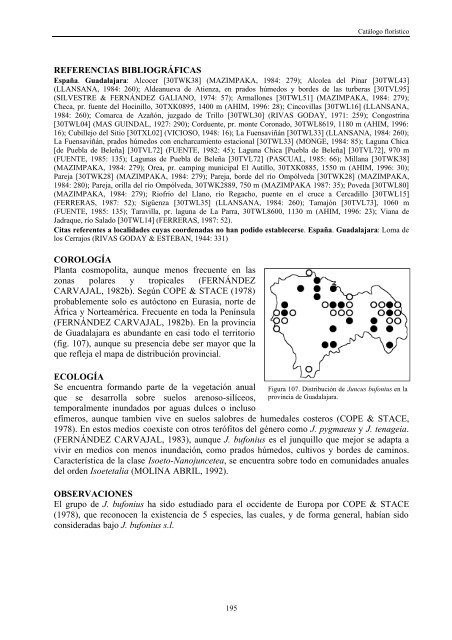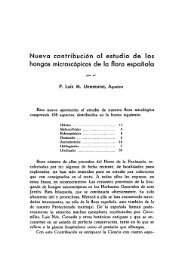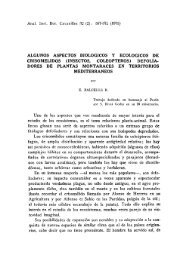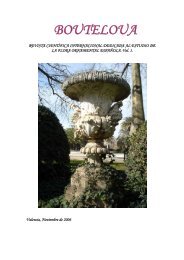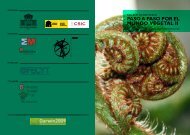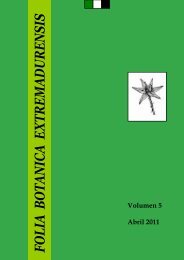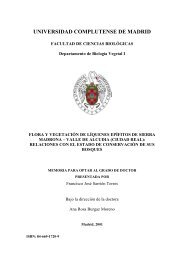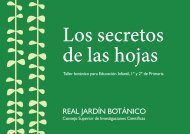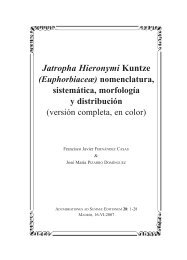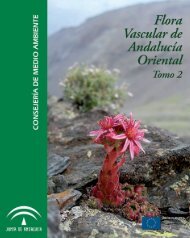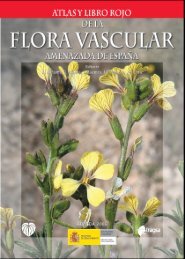- Page 1:
UNIVERSIDAD AUTÓNOMA DE MADRIDFACU
- Page 5 and 6:
Pasé mucho tiempo en sitios que en
- Page 8:
ÍNDICE1. INTRODUCCIÓN............
- Page 12 and 13:
2. ANTECEDENTES BOTÁNICOSLa provin
- Page 14 and 15:
Antecedentes1979. Salvador Rivas Go
- Page 16 and 17:
Antecedentescon la tesis doctoral d
- Page 18:
Antecedentesrefiere a la cuenca de
- Page 21 and 22:
L. Medina (2003). Flora y vegetaci
- Page 23 and 24:
L. Medina (2003). Flora y vegetaci
- Page 25 and 26:
L. Medina (2003). Flora y vegetaci
- Page 27 and 28:
L. Medina (2003). Flora y vegetaci
- Page 29 and 30:
L. Medina (2003). Flora y vegetaci
- Page 31 and 32:
L. Medina (2003). Flora y vegetaci
- Page 33 and 34:
L. Medina (2003). Flora y vegetaci
- Page 35 and 36:
L. Medina (2003). Flora y vegetaci
- Page 39 and 40:
L. Medina (2003). Flora y vegetaci
- Page 41 and 42:
L. Medina (2003). Flora y vegetaci
- Page 43 and 44:
L. Medina (2003). Flora y vegetaci
- Page 45 and 46:
L. Medina (2003). Flora y vegetaci
- Page 47 and 48:
L. Medina (2003). Flora y vegetaci
- Page 49 and 50:
L. Medina (2003). Flora y vegetaci
- Page 52 and 53:
4. CATÁLOGO FLORÍSTICO4.1 INTRODU
- Page 54 and 55:
Catálogo florísticoespecial distr
- Page 56:
Catálogo florístico- Mapas provin
- Page 59 and 60:
L. Medina (2003). Flora y vegetaci
- Page 61 and 62:
L. Medina (2003). Flora y vegetaci
- Page 63 and 64:
L. Medina (2003). Flora y vegetaci
- Page 65 and 66:
L. Medina (2003). Flora y vegetaci
- Page 67 and 68:
L. Medina (2003). Flora y vegetaci
- Page 69 and 70:
L. Medina (2003). Flora y vegetaci
- Page 71 and 72:
L. Medina (2003). Flora y vegetaci
- Page 73 and 74:
L. Medina (2003). Flora y vegetaci
- Page 75 and 76:
L. Medina (2003). Flora y vegetaci
- Page 77 and 78:
L. Medina (2003). Flora y vegetaci
- Page 79 and 80:
L. Medina (2003). Flora y vegetaci
- Page 81 and 82:
L. Medina (2003). Flora y vegetaci
- Page 83 and 84:
L. Medina (2003). Flora y vegetaci
- Page 85 and 86:
L. Medina (2003). Flora y vegetaci
- Page 87 and 88:
L. Medina (2003). Flora y vegetaci
- Page 89 and 90:
L. Medina (2003). Flora y vegetaci
- Page 91 and 92:
L. Medina (2003). Flora y vegetaci
- Page 93 and 94:
L. Medina (2003). Flora y vegetaci
- Page 95 and 96:
L. Medina (2003). Flora y vegetaci
- Page 97 and 98:
L. Medina (2003). Flora y vegetaci
- Page 99 and 100:
L. Medina (2003). Flora y vegetaci
- Page 101 and 102:
L. Medina (2003). Flora y vegetaci
- Page 103 and 104:
L. Medina (2003). Flora y vegetaci
- Page 105 and 106:
L. Medina (2003). Flora y vegetaci
- Page 107 and 108:
L. Medina (2003). Flora y vegetaci
- Page 109 and 110:
L. Medina (2003). Flora y vegetaci
- Page 111 and 112:
L. Medina (2003). Flora y vegetaci
- Page 113 and 114:
L. Medina (2003). Flora y vegetaci
- Page 115 and 116:
L. Medina (2003). Flora y vegetaci
- Page 117 and 118:
L. Medina (2003). Flora y vegetaci
- Page 119 and 120:
L. Medina (2003). Flora y vegetaci
- Page 121 and 122:
L. Medina (2003). Flora y vegetaci
- Page 123 and 124:
L. Medina (2003). Flora y vegetaci
- Page 125 and 126:
L. Medina (2003). Flora y vegetaci
- Page 127 and 128:
L. Medina (2003). Flora y vegetaci
- Page 129 and 130:
L. Medina (2003). Flora y vegetaci
- Page 131 and 132:
L. Medina (2003). Flora y vegetaci
- Page 133 and 134:
L. Medina (2003). Flora y vegetaci
- Page 135 and 136:
L. Medina (2003). Flora y vegetaci
- Page 137 and 138:
L. Medina (2003). Flora y vegetaci
- Page 139 and 140:
L. Medina (2003). Flora y vegetaci
- Page 141 and 142:
L. Medina (2003). Flora y vegetaci
- Page 143 and 144:
L. Medina (2003). Flora y vegetaci
- Page 145 and 146:
L. Medina (2003). Flora y vegetaci
- Page 147 and 148:
L. Medina (2003). Flora y vegetaci
- Page 149 and 150:
L. Medina (2003). Flora y vegetaci
- Page 151 and 152: L. Medina (2003). Flora y vegetaci
- Page 153 and 154: L. Medina (2003). Flora y vegetaci
- Page 155 and 156: L. Medina (2003). Flora y vegetaci
- Page 157 and 158: L. Medina (2003). Flora y vegetaci
- Page 159 and 160: L. Medina (2003). Flora y vegetaci
- Page 161 and 162: L. Medina (2003). Flora y vegetaci
- Page 163 and 164: L. Medina (2003). Flora y vegetaci
- Page 165 and 166: L. Medina (2003). Flora y vegetaci
- Page 167 and 168: L. Medina (2003). Flora y vegetaci
- Page 169 and 170: L. Medina (2003). Flora y vegetaci
- Page 171 and 172: L. Medina (2003). Flora y vegetaci
- Page 173 and 174: L. Medina (2003). Flora y vegetaci
- Page 175 and 176: L. Medina (2003) Flora y vegetació
- Page 177 and 178: L. Medina (2003) Flora y vegetació
- Page 179 and 180: L. Medina (2003) Flora y vegetació
- Page 181 and 182: L. Medina (2003) Flora y vegetació
- Page 183 and 184: L. Medina (2003) Flora y vegetació
- Page 185 and 186: L. Medina (2003) Flora y vegetació
- Page 187 and 188: L. Medina (2003) Flora y vegetació
- Page 189 and 190: L. Medina (2003) Flora y vegetació
- Page 191 and 192: L. Medina (2003). Flora y vegetaci
- Page 193 and 194: L. Medina (2003). Flora y vegetaci
- Page 195 and 196: Catálogo florísticopozas. Se encu
- Page 197 and 198: L. Medina (2003) Flora y vegetació
- Page 199 and 200: L. Medina (2003) Flora y vegetació
- Page 201: L. Medina (2003) Flora y vegetació
- Page 205 and 206: L. Medina (2003) Flora y vegetació
- Page 207 and 208: L. Medina (2003) Flora y vegetació
- Page 209 and 210: L. Medina (2003) Flora y vegetació
- Page 211 and 212: L. Medina (2003) Flora y vegetació
- Page 213 and 214: L. Medina (2003) Flora y vegetació
- Page 215 and 216: L. Medina (2003) Flora y vegetació
- Page 217 and 218: L. Medina (2003) Flora y vegetació
- Page 219 and 220: L. Medina (2003) Flora y vegetació
- Page 221 and 222: L. Medina (2003) Flora y vegetació
- Page 223 and 224: L. Medina (2003) Flora y vegetació
- Page 225 and 226: L. Medina (2003) Flora y vegetació
- Page 227 and 228: L. Medina (2003) Flora y vegetació
- Page 229 and 230: L. Medina (2003) Flora y vegetació
- Page 231 and 232: L. Medina (2003) Flora y vegetació
- Page 233 and 234: L. Medina (2003) Flora y vegetació
- Page 235 and 236: L. Medina (2003) Flora y vegetació
- Page 237 and 238: L. Medina (2003) Flora y vegetació
- Page 239 and 240: L. Medina (2003) Flora y vegetació
- Page 241 and 242: L. Medina (2003) Flora y vegetació
- Page 243 and 244: L. Medina (2003) Flora y vegetació
- Page 245 and 246: L. Medina (2003) Flora y vegetació
- Page 247 and 248: L. Medina (2003) Flora y vegetació
- Page 249 and 250: L. Medina (2003) Flora y vegetació
- Page 251 and 252: L. Medina (2003) Flora y vegetació
- Page 253 and 254:
L. Medina (2003) Flora y vegetació
- Page 255 and 256:
L. Medina (2003) Flora y vegetació
- Page 257 and 258:
L. Medina (2003) Flora y vegetació
- Page 259 and 260:
L. Medina (2003) Flora y vegetació
- Page 261 and 262:
L. Medina (2003) Flora y vegetació
- Page 263 and 264:
L. Medina (2003) Flora y vegetació
- Page 265 and 266:
L. Medina (2003) Flora y vegetació
- Page 267 and 268:
L. Medina (2003) Flora y vegetació
- Page 269 and 270:
L. Medina (2003) Flora y vegetació
- Page 271 and 272:
L. Medina (2003) Flora y vegetació
- Page 273 and 274:
L. Medina (2003) Flora y vegetació
- Page 275 and 276:
L. Medina (2003) Flora y vegetació
- Page 277 and 278:
L. Medina (2003) Flora y vegetació
- Page 279 and 280:
L. Medina (2003) Flora y vegetació
- Page 281 and 282:
L. Medina (2003) Flora y vegetació
- Page 283 and 284:
L. Medina (2003) Flora y vegetació
- Page 285 and 286:
L. Medina (2003) Flora y vegetació
- Page 287 and 288:
L. Medina (2003) Flora y vegetació
- Page 289 and 290:
L. Medina (2003) Flora y vegetació
- Page 291 and 292:
L. Medina (2003) Flora y vegetació
- Page 293 and 294:
L. Medina (2003) Flora y vegetació
- Page 295 and 296:
L. Medina (2003) Flora y vegetació
- Page 297 and 298:
L. Medina (2003) Flora y vegetació
- Page 299 and 300:
L. Medina (2003) Flora y vegetació
- Page 301 and 302:
L. Medina (2003) Flora y vegetació
- Page 303 and 304:
L. Medina (2003) Flora y vegetació
- Page 305 and 306:
L. Medina (2003) Flora y vegetació
- Page 307 and 308:
L. Medina (2003) Flora y vegetació
- Page 309 and 310:
L. Medina (2003) Flora y vegetació
- Page 311 and 312:
L. Medina (2003) Flora y vegetació
- Page 313 and 314:
L. Medina (2003) Flora y vegetació
- Page 315 and 316:
L. Medina (2003) Flora y vegetació
- Page 317 and 318:
L. Medina (2003) Flora y vegetació
- Page 319 and 320:
L. Medina (2003) Flora y vegetació
- Page 321 and 322:
L. Medina (2003) Flora y vegetació
- Page 323 and 324:
L. Medina (2003) Flora y vegetació
- Page 325 and 326:
L. Medina (2003) Flora y vegetació
- Page 328 and 329:
5 LAS LAGUNAS Y HUMEDALES DE LA PRO
- Page 330 and 331:
Lagunas y humedalesPuebla de Beleñ
- Page 332 and 333:
Lagunas y humedalesEl catálogo de
- Page 334 and 335:
Lagunas y humedalesLagunas de Puebl
- Page 336 and 337:
Lagunas y humedales5.2. EL CATÁLOG
- Page 338 and 339:
Lagunas y humedales5.3. LAS LAGUNAS
- Page 340 and 341:
Lagunas y humedalesFigura 195. Loca
- Page 342 and 343:
Lagunas y humedalesFigura 196. Loca
- Page 344 and 345:
Lagunas y humedalessedimentos plioc
- Page 346 and 347:
Lagunas y humedalesEn 1998, con fin
- Page 348 and 349:
Lagunas y humedalesLAGUNAS1 2 3 4 5
- Page 350 and 351:
Lagunas y humedalesCharcas del barr
- Page 352 and 353:
Lagunas y humedales5.3.2. LAS LAGUN
- Page 354 and 355:
Lagunas y humedalesLAS LAGUNAS TRAV
- Page 356 and 357:
Lagunas y humedalesestas aguas. Los
- Page 358 and 359:
Lagunas y humedalesLa representaci
- Page 360 and 361:
Lagunas y humedalesLos fenómenos c
- Page 362 and 363:
Lagunas y humedalesLos grupos de ch
- Page 364 and 365:
Lagunas y humedalesCHARCAS1 2 3 4 5
- Page 366 and 367:
Lagunas y humedales5.3.4. LAS SALIN
- Page 368 and 369:
Lagunas y humedalesEl proceso de ex
- Page 370 and 371:
Lagunas y humedalesFigura 202. Loca
- Page 372 and 373:
Lagunas y humedalesSalinas del ento
- Page 374 and 375:
Lagunas y humedalesLa escasa superf
- Page 376:
Lagunas y humedalesEn la laguna se
- Page 379 and 380:
L. Medina (2003) Flora y vegetació
- Page 382 and 383:
7. BIBLIOGRAFÍAREFERENCIAS BIBLIOG
- Page 384 and 385:
BibliografíaBARRY, R. & WADE, P.M.
- Page 386 and 387:
BibliografíaCantalojas (Guadalajar
- Page 388 and 389:
BibliografíaCIRUJANO, S., PASCUAL,
- Page 390 and 391:
BibliografíaFENNANE, M. & IBN TATT
- Page 392 and 393:
BibliografíaFUERTES LASALA, E. (19
- Page 394 and 395:
BibliografíaGUERRA ESTAPÉ, J. (19
- Page 396 and 397:
BibliografíaLLAMAS GARCÍA, F. (19
- Page 398 and 399:
BibliografíaMATEO, G. & PISCO, J.M
- Page 400 and 401:
BibliografíaMONGE, C. (1991). Flor
- Page 402 and 403:
BibliografíaPASCUAL TORRES, P. (19
- Page 404 and 405:
BibliografíaQUERALT, R. & PASCUAL,
- Page 406 and 407:
BibliografíaRIVAS MATEOS, M. (1900
- Page 408 and 409:
BibliografíaSEGURA ZUBIZARRETA, A.
- Page 410 and 411:
BibliografíaUniversitario Arcos de
- Page 413 and 414:
8. ÍNDICE DE GÉNEROSSe recogen la
- Page 415 and 416:
LAGUNAS39 40 41 42 43 44 45 46 47 4
- Page 417:
PLANTAS ACUÁTICASCallitriche bruti


